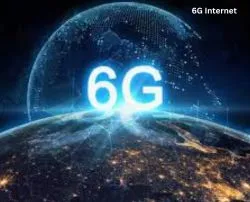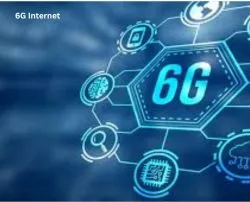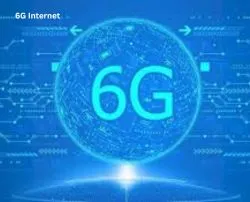Introduction
6G Internet speed offers projected to be 100 times faster than 5G thus enabling significant alteration of digital life patterns during work and social encounters. Technology never stands still. When the 2G network launched people believed text messaging was revolutionary at that time. The introduction of 3G mobile internet was followed by 4G which revolutionized streaming along with web browsing. The current 5G network gives users unprecedented data speed capabilities and minimal latency performance.
But what comes after 5G?The upcoming 6G Internet technology will launch commercially beginning 2035 to become the next wireless revolution. We should examine the upcoming future of 6G.
Understanding 6G Internet

What is 6G Internet?
The sixth wireless technology generation known as 6G Internet operates at terabit speeds which exceed Tbps. The introduction of gigabit speeds by 5G networks would mark the beginning of terabit levels by 6G Internet speed. The power of 6G technology includes artificial intelligence (AI) enhancement combined with terahertz (THz) frequency bandwidth alongside quantum connectivity for delivering exceptional high-speed connections.
Why Do We Need 6G?
People question why more investment in 6G technology is essential since 5G networks are beginning their deployment. The next generation of technologies surpasses the capabilities that 5G technology can deliver. Autonomous vehicles, remote robotic procedures, holographic interactions and the linking of smart urban areas function through instant large-data transfers. The essential role of 6G Internet speed comes into play in this situation.
Key Features of 6G Internet

Unprecedented Speed
Internet speed through 6G technology will exceed 1 Tbps which represents 100 times faster than 5G speeds. 8K movies could be fully downloaded within one second through 6G Internet while ultra-HD virtual reality streaming works smoothly without any delay. The exceptional 6G Internet speed will establish communication possibilities that society has never seen before.
Ultra-Low Latency
6G Internet speed will be so fast that it will achieve latency below one millisecond. This enables instant communication for healthcare procedures like robot-assisted surgery as well as telepresence holographic communication.
AI-Integrated Networks
Every network aspect from traffic management to bandwidth administration along with fault prevention and network healing capabilities will be handled by AI technology under 6G networks. Users with 6G networks equipped with AI integration will receive seamless high-quality service at every moment.
Terahertz (THz) Frequency Bands
The next-generation communication system of 6G will shift away from 4G and 5G GHz operation by utilizing THz frequency bands instead. A completely new network infrastructure will be mandatory for data transmission at faster speeds through this technology which represents groundbreaking network development.
Energy Efficiency & Sustainability
6G technology seeks to achieve environmental sustainability among its primary objectives. The implementation of AI-based energy algorithms ensures fast and sustainable performance in 6G Internet speed.
Holographic and Extended Reality (XR) Applications
Full XR capabilities together with holographic interaction standards will become reality soon. 6G Internet speed enables people to lead meetings using holograms and experience augmented reality cities as part of everyday life.
How 6G Internet Will Transform Industries

Healthcare Innovations
Health monitoring systems using AI diagnostics and real-time performance analysis as well as robotic surgeries become achievable through 6G Internet speed and stability. Cells operated on patients who were located extremely distant from each other.
Smart Cities and IoT Expansion
Real-time communication between traffic lights sensors drones and public services is possible through 6G which power high-density IoT networks thus creating efficient operation in cities.
Industrial Automation and AI Integration
Manufacturing premises will become fully automated through real-time robot communication leading to diminished costs while keeping both humans and machines secure.
Space Communication & Global Connectivity
Through satellite connections 6G will achieve internet access across the entire globe to reach distant locations. The entire world will eliminate its digital gap.
Challenges in Developing 6G Internet

Infrastructure Overhaul
A fresh infrastructure must be constructed as a necessary step to implement 6G technology. The deployment of Terahertz frequencies requires new equipment sets alongside dense base stations to function properly which comes at a high cost for implementation.
Security & Privacy Concerns
More speed means more risk. To accomplish 6G Internet speed operators will require advanced encryption combined with artificial intelligence for protecting sensitive data.
Spectrum Allocation Challenges
The frequency allocation in the THz band remains restricted while experiencing increased competition. Spectrum allocation requires international organizations and government bodies to work together for ethical and effective system management.
Countries Leading the 6G Race

USA & China
The two leading powers in 6G R&D research initiative. Huawei together with Qualcomm and Apple allocate substantial funds to gain control over future 6G Internet networks.
Europe & Japan
The research efforts of European and Japanese scientists concentrate on standard development as well as framework development for 6G. Their goal? A globally accepted network protocol.
India & Emerging Markets
The nation of India prepares itself for significant advancement in 6G technology development. New markets will experience substantial growth through cost-effective and accessible internet as well as technological equal access.
The Road to 2035: When Will 6G Be Available?

The journey has already begun.
- 2023–2029: Research and early lab testing
- 2030: Pilot testing and global framework discussions
- 2035: Commercial launch of 6G networks
- 2035–2040: Gradual global adoption and user-level integration
Conclusion
A technology revolution occurs in network connectivity when comparing 6G Internet to 5G and previous generations of communication standards. 6G Internet speed will transform industries and human relationships because it offers 1 Tbps speeds with low latency and intelligent network management. 6G serves as an innovation platform to establish sustainable framework while ensuring universal access between technologies and communities.
Despite obstacles we will reach 2035 to build an instant intelligent and immersive communication world.
FAQs
1. What is 6G Internet and how is it different from 5G?
The future wireless network standard 6G Internet will generate speeds 100 times faster than 5G through operating on terahertz frequencies and using AI for power distribution. The new system will handle applications including extended reality alongside holography and it will achieve ultra-fast speeds with minimal delay in transmission.
2. When can we expect 6G to be available for consumers?
The first tests of 6G Internet are predicted to start by 2030 followed by a commercial debut during 2035. The technology will ramp up into widespread use during the following years.
3. What industries will benefit the most from 6G Internet?
6G Internet speed and connectivity features will be most beneficial for healthcare institutions and smart city development along with autonomous vehicles and manufacturing sector and space-based communication systems.
4. How fast will 6G Internet be compared to 5G?
Research indicates that 6G Internet speed is 1 Tbps will reach 100 times the speed of its predecessor 5G.
5. What are the biggest challenges in developing 6G technology?
Major challenges include:
- Constructing new THz frequency infrastructure represents one of the main challenges for 6G development.
- Tackling security risks.
- Allocating limited spectrum.
- Coordinating global standards.












